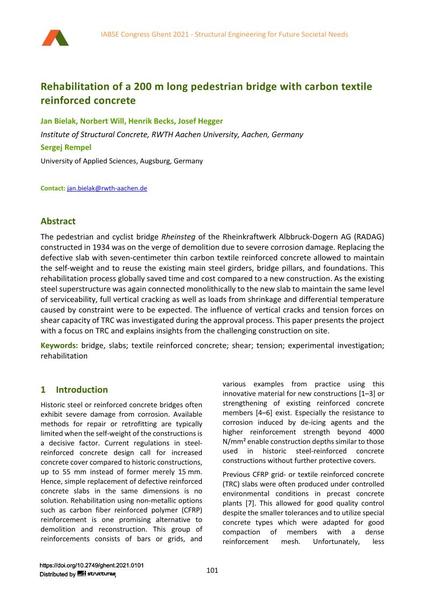Rehabilitation of a 200 m long pedestrian bridge with carbon textile reinforced concrete

|
|
|||||||||||
Bibliographic Details
| Author(s): |
Jan Bielak
(Institute of Structural Concrete, RWTH Aachen University, Aachen, Germany)
Norbert Will (Institute of Structural Concrete, RWTH Aachen University, Aachen, Germany) Henrik Becks (Institute of Structural Concrete, RWTH Aachen University, Aachen, Germany) Josef Hegger Sergej Rempel (University of Applied Sciences, Augsburg, Germany) |
||||
|---|---|---|---|---|---|
| Medium: | conference paper | ||||
| Language(s): | English | ||||
| Conference: | IABSE Congress: Structural Engineering for Future Societal Needs, Ghent, Belgium, 22-24 September 2021 | ||||
| Published in: | IABSE Congress Ghent 2021 | ||||
|
|||||
| Page(s): | 101-108 | ||||
| Total no. of pages: | 8 | ||||
| DOI: | 10.2749/ghent.2021.0101 | ||||
| Abstract: |
The pedestrian and cyclist bridge Rheinsteg of the Rheinkraftwerk Albbruck-Dogern AG (RADAG) constructed in 1934 was on the verge of demolition due to severe corrosion damage. Replacing the defective slab with seven-centimeter thin carbon textile reinforced concrete allowed to maintain the self-weight and to reuse the existing main steel girders, bridge pillars, and foundations. This rehabilitation process globally saved time and cost compared to a new construction. As the existing steel superstructure was again connected monolithically to the new slab to maintain the same level of serviceability, full vertical cracking as well as loads from shrinkage and differential temperature caused by constraint were to be expected. The influence of vertical cracks and tension forces on shear capacity of TRC was investigated during the approval process. This paper presents the project with a focus on TRC and explains insights from the challenging construction on site. |
||||
| Keywords: |
bridge slabs experimental investigation rehabilitation shear tension textile reinforced concrete
|
||||
| Copyright: | © 2021 International Association for Bridge and Structural Engineering (IABSE) | ||||
| License: | This creative work is copyrighted material and may not be used without explicit approval by the author and/or copyright owner. |
||||
